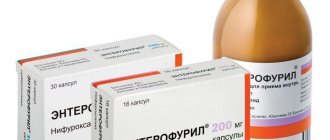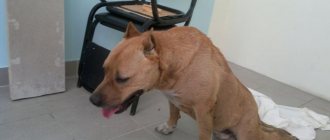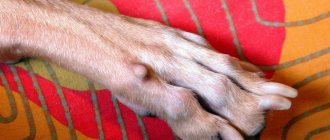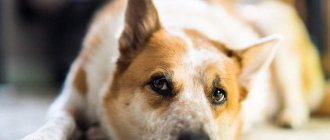Nowadays, there are many sources of information for pet owners. Some veterinary clinics even offer first aid courses, introduction to pharmacology, and so on. That is, any responsible owner can acquire information that will help recognize conditions that require the help of a veterinarian.
Today we will try to replenish your knowledge. Let's discuss the problem of bloating in dogs.
About abdominal tension, see our other article:
Forms of pathology
Bloating is just a symptom, not an independent disease. It cannot be cured without eliminating the root cause. Depending on the severity of the accompanying symptoms, there are 2 forms of this pathological condition: acute and chronic.
Acute
The acute form occurs suddenly and is accompanied by severe discomfort. Due to pain, the pet may whine restlessly and arch its back. Symptoms quickly increase and are complemented by:
- decreased or complete loss of appetite;
- diarrhea and foamy vomiting with mucus or blood clots;
- breathing problems, shortness of breath;
- bulging eyes;
- hiccups and belching;
- loss of coordination and limb failure;
- blue mucous membranes.
Most often, this picture occurs when there is excessive gas formation, excess air or liquid. All these conditions put pressure on internal organs and can lead to death. To save the four-legged animal, emergency surgery may be required.
Chronic
The chronic form of the pathology occurs unnoticed for both the owner and the pet. It can only be detected during an examination at a veterinary clinic or at the time of relapse, when the symptoms become more pronounced. This picture is typical for gastrointestinal pathologies, kidney diseases and hormonal disorders.
Why is it important to carry out diagnostics in a veterinary clinic?
Symptomatic treatment provides only a temporary effect. For this reason, it is very important to undergo a complete diagnosis at a veterinary clinic. This is the only way to find out the source of bloating and select drugs that specifically affect it.
Another important point in favor of seeing a doctor is the high likelihood of complications. The most dangerous include volvulus of the stomach and intestines, which can be fatal. Without timely treatment, your pet's condition may worsen. The sooner you take him for examination, the easier the treatment will be.
Digestion
During the normal digestion process, gases are formed in the intestinal tract. Foul gas is often produced by bacteria in the colon that break down foods that have not been fully digested in the stomach and small intestine.
This can be seen with poor diet (such as ending up in the trash or eating food outdoors). Certain specific foods, such as peas, beans, milk and dairy products, as well as diets very high in meat, can cause bloating in dogs.
Causes of bloating in dogs and methods of treatment
To determine the cause of the pathological condition, it is very important to record the accompanying symptoms, as well as the time of onset of pain attacks. This will help narrow down the possible diagnoses.
Swallowing air while eating
Eating food too quickly leads to the fact that not only food, but also air enters the stomach. Its excess provokes increased gas formation, which inflates the tummy.
You can get rid of this problem yourself. To do this, you need to review the diet and feed your pet only at certain hours. Please note that the breaks between meals should be equal. This will help eliminate the problem of prolonged fasting.
Many animals benefit from a bowl with special dividers. It prevents rapid swallowing and forces you to fish out each piece of food for a very long time.
Gas formation (flatulence)
Flatulence occurs in dogs due to the abundance of gases inside the stomach or intestines. It is easy to recognize by its characteristic symptoms:
- hiccups;
- nausea;
- frequent belching;
- spasms;
- loss of appetite.
The gassy tummy swells and growls. It becomes dense to the touch, like a drum. If the described picture is accompanied by constipation, make an appointment with a veterinarian. Prolonged stagnation of feces causes severe intoxication, impairing the functionality of internal organs.
Gastrointestinal problems
The causes of flatulence in dogs include problems with the gastrointestinal tract. They include the following pathologies:
- Intestinal obstruction. A prolonged delay in defecation is accompanied by severe intoxication and an increase in internal pressure, which can lead to intestinal rupture. The pathology is caused by balls of worms, hairballs, foreign bodies and fecal stones (hard feces).
- Tumors. They make digestion difficult and disrupt the functionality of internal organs.
- Enzyme deficiency. The lack of the required amount of enzymes interferes with the absorption of nutrients. This often leads to weight loss, deterioration of coat quality and distortion of appetite.
- Gastritis. Accompanied by the proliferation of fibrous tissue on the gastric mucosa. May be complicated by gastric volvulus.
- Volvulus of the stomach or intestines. This pathology is deadly. It causes mechanical twisting of the digestive tract organs, preventing the movement of eaten food.
Please note that tissue necrosis develops during volvulus. All damaged areas must be removed. The most optimal prognosis is given when seeking help within 1-1.5 hours from the onset of the attack.
Peritonitis
A hard belly in a dog can be a sign of peritonitis, which is inflammation of the serous lining of the abdominal cavity. This pathology develops against the background of infections, helminthiases and perforation of internal organs with subsequent spillage of their contents. Very often peritonitis is accompanied by ascites, or abdominal dropsy.
Ascites, or abdominal dropsy
With ascites, free fluid accumulates in the abdominal cavity: blood, pus or urine. Because of this, the stomach becomes rounded, as during pregnancy. Putting your pet on its hind legs will help you find out the exact reason.
When taking a vertical position, all the liquid will rush down, and the tummy will take on a characteristic pear-shaped shape. After assuming a natural position (stand on all four paws), the shape will again become round.
Infection with worms
The main symptoms of helminthiasis are vomiting and diarrhea. With their help, the body tries to get rid of the toxic waste products of parasites. In addition to acute intoxication, advanced helminthiasis is dangerous due to intestinal blockage. The worms intertwine with each other, forming balls, and block the path for the exit of feces.
Pyometra and other gynecological problems
Another possible cause is pyometra and other gynecological problems of an inflammatory nature. Due to the accumulating pus, the uterus enlarges, and the abdomen grows along with it. Inflammation is accompanied by severe weakness and fever.
Pyometra can be open or closed. When the form is open, some of the pus drains from the vulva, facilitating early diagnosis. When the form is closed, the outflow of fluid is impossible, so animals often die from intoxication due to uterine rupture.
Obesity
Excess weight creates excess pressure on internal organs, causing pathologies of the esophagus, diseases of the colon, liver and biliary tract. A fat dog often suffers from belching after eating, regurgitation, nausea and hiccups.
If your pet's weight exceeds the recommended norm, put him on a diet. Reduce your usual portions and add more activity.
Pregnancy
During pregnancy, the tummy is soft and most often painless, which distinguishes it from pathological conditions. Other characteristic features include the following:
- decreased activity (refusal of long walks, increased sleep duration);
- manifestation of anxiety in noisy companies (the expectant mother constantly tries to hide in a secluded corner);
- sudden increase or decrease in appetite;
- morning sickness and vomiting;
- the appearance of viscous mucus from the loop and swelling of the nipples.
A noticeable rounding of the tummy occurs in late pregnancy. If your pet shows unusual aggression, actively builds a “nest” and refuses to eat, get ready for an early birth. After a decrease in body temperature by 1-1.5 ° C, no more than 1.5 hours remain until the puppies appear.
Unplanned pregnancy
The second possible reason is unplanned pregnancy in bitches. Mating could occur without the knowledge of the owner if the dog was left to its own devices for a long time. In this condition, symptoms such as:
- engorgement, enlargement and change in color of the nipples;
- changes in the pet's behavior;
- refusal of some food;
- nausea or vomiting.
In this case, you should immediately show the animal to a doctor - only he will be able to clarify the timing and normality of gestation.
How and what first aid can be provided
If your dog has a swollen belly, he should be taken to the veterinarian. Incorrectly selected treatment on your own is fraught with the development of complications, including death. Only first aid aimed at temporary relief of the condition is allowed.
Use of sorbents
Sorbents are the most affordable and effective drugs for intoxication. Usually every home has activated carbon, Smecta, Polysorb or Enterosgel. Before using them, be sure to read the instructions to calculate the dosage for your pet.
Vaseline oil
This remedy is used for constipation. It dilutes feces well and is completely eliminated from the body, which eliminates overdose.
The oil is poured orally, that is, directly into the mouth. For 1 kg of dog weight, 1 ml of medicine is required. It should be given 2 times a day until stool normalizes. Relief of the condition is noted in the first 5 hours after use.
Starvation diet
The load on the gastrointestinal tract must be reduced, so it is recommended that the dog be completely deprived of food before the examination. Please note that water must remain freely available. This will prevent dehydration.
When self-medication is prohibited
Despite the safety and effectiveness of the listed methods, in some cases they are strictly prohibited. Contraindications include:
- injuries and tumors in the gastrointestinal tract;
- heat;
- increased heart rate and breathing;
- pathologies of the heart and kidneys;
- severe dehydration;
- pregnancy;
- frequent vomiting;
- any suspicion of intestinal blockage;
- bleeding from the anus.
Also strictly prohibited are enemas, laxatives and abdominal massage. If you are unsure of your actions, consult your doctor by phone. 24-hour veterinary clinics will help you with advice even in the middle of the night.
Prevention
The most important preventive measures are the following:
- Careful adherence to the rules of feeding the dog, in which any “human” food that is unusual for dogs is strictly prohibited.
- Timely and regular expulsion of worms.
- Use only high-quality feed and fresh food in full compliance with hygiene rules.
- Making sure that the dog does not pick up anything from the ground on the street. To do this, from early childhood he is taught not to eat anything outside the home.
- Do not feed your dog before a walk. An overfilled stomach during significant physical exertion can cause intestinal volvulus.
- If dangerous symptoms appear, such as vomiting with foam, contact your veterinarian immediately.
Monitoring your dog’s health is much easier and more effective than trying to cure it of serious consequences.
In what cases should you go to the doctor?
In some situations, delay can be fatal. You need to go to the veterinary clinic right now if:
- The dog’s stomach became swollen a day ago, but there was no improvement;
- the frequency of vomiting is more than 2 times a day, and the masses themselves contain foreign impurities;
- there is profuse salivation;
- body temperature is higher than normal and the pet is trembling strongly;
- signs of suffocation appeared (shortness of breath, blue mucous membranes).
Before transporting, carefully lay the animal on its side. This will make it easier for vomit to come out while moving.
Depending on the diagnosis, medical or surgical treatment may be required. Most often, surgery is used for volvulus, peritonitis and pyometra.
How to treat bloating
Sometimes it happens that a dog’s stomach is swollen, and there are no veterinary clinics nearby, only pharmacies. At the initial stage, you can alleviate your pet’s suffering with the help of anti-flatulence medications and sorbents. But you need to understand that treatment at home can only be done in cases where it is known that the disorder is associated with unnatural food. In all other situations, self-medicating at home is dangerous. Only a veterinarian will be able to make an accurate diagnosis and determine treatment methods: deworming, drug support or surgery. With any swelling of the abdominal cavity, there is a high risk of death of your four-legged friend.
What can you give?
In order to reduce gas pressure on the abdominal cavity, give regular children's medications for gas formation, for example, Espumisan and its analogues. Smecta, Enterosgel will relieve reporting and irritation. To cleanse the intestines, feed Duphalac or its analogues.
An excellent entrosorbent that removes harmful substances from the gastrointestinal tract is Enterozoo. The drug is sold in veterinary pharmacies. If possible, it is better to stock up on it in advance so that the medicine is always present in the first aid kit.
Carefully review your diet and determine by elimination which food triggered the bloating of the abdominal cavity.
If your dog is diagnosed with ascites, there is no need to despair and immediately agree to euthanasia. Many doctors suggest putting the animal to sleep immediately, but in veterinary practice there are known cases of recovery from dropsy when the owners cared for the animal for a long time and carefully, completely changing the diet.
First of all, food is given not 1-2 times, but in small portions.
The food is mainly protein: chicken, beef, kefir, cottage cheese, fish and porridge. The dog is fed veroshpiron according to the doctor's instructions (2 tablets per day) - this is a diuretic taken for heart failure, liver cirrhosis, and emerging edematous syndromes. After a course of veroshpiron, take Panangin. Non-bitter kidney tea is added to the food: the dog most likely will not drink bitter medicine. The dog also needs vitamins, for example, Aevit, and restrictions on drinking, because it will happily gulp down all the water offered.
What is strictly prohibited for swollen peritoneum:
- Do massage;
- give activated charcoal or a laxative;
- give an enema.
Risk groups by breed
In most cases, large, barrel-chested breeds suffer from bloat. This feature is typical for:
- St. Bernards;
- Dobermans;
- Labradors;
- German Shepherds;
- Rottweilers;
- Great Danes;
- standard (royal) poodles;
- golden retrievers;
- bobtails.
In addition to breed predisposition, there is a relationship with age. The diseases listed above are usually diagnosed in animals over 7 years of age, suffering from chronic pathologies and leading a “sofa” lifestyle.
Diet for gastrointestinal problems
Until recovery, dry and solid foods, fatty meat broths and animal proteins are excluded from the usual menu. The feeding regime is also changed. The dog is fed more often, but in smaller portions.
Further recommendations depend on the type of feeding:
- Ready-made feed. Instead of granules, they give wet canned food and meat pieces in packages. When changing your usual diet, it is important not to make a sudden transition. The finished food should be from a brand familiar to your pet.
- Natural products. The daily diet includes slimy porridge in water, boiled vegetables, well-cooked fish (only sea fish and without bones) and fermented milk products with a reduced percentage of fat content.
Please note that increased gas formation is caused by legumes, milk and most food from the human table. All these products are included in the prohibited list even for healthy four-legged animals. If this is your first time seeing this information, be sure to read the more complete list to protect your pet.











